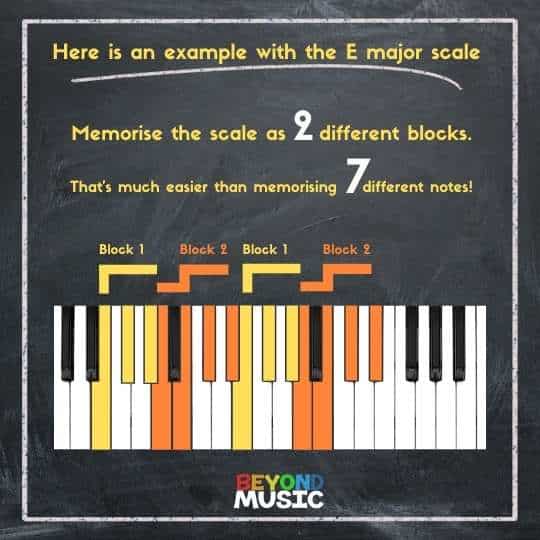How to Remember Scales

How to Remember Scales
Memorising scales can be tricky. The reason why it is tricky is likely due to trying to remember the scale as eight individual notes as well as not doing anything actively to memorise those notes.
In this chapter, we will introduce some techniques that will make it a lot easier to memorise new scales, chords and passages. This is suitable for all instruments.
Memorising scales is easier and more effective if you expand your field of view or field of focus and see the bigger picture of the scale. Think about it as driving a car. When you learn how to drive, you are taught that you need to look further afield instead of right in front of the car taking in only ten meters at a time. Instead, your eyes should adopt a relaxed focus and take in a hundred meters at a time. This will remove a lot of strain for your eyes and brain. By seeing more than just ten meters in front of you and by using your peripheral vision, you perform turns more accurately and smoothly, and you will be ready to react to potential dangers further away from you because you will notice them sooner.
It is the same with playing instruments, and this is the core idea in a lot of methods and techniques explained in this guide. By being aware of how to do the whole scale before you start it, you will play it more smoothly and also increase your chances of remembering it. In this section are some methods and techniques that use this expanded field of focus as a base and builds on that. Each exercise adds a layer of specificity depending on what it is that you are doing. Visualisation plays a major part in these exercises.
Seeing the patterns of scales, chords or melodic phrases
Let us use the E major scale as an example. Instead of dividing the E major scale into eight different parts – one part for each note – it is much easier to memorise if we divide it into two parts. Using the piano as an example, we know that the fingering for many of the easier scales goes like this:
E F# G# A B C# D#
1 2 3 1 2 3 4
And there we have our two parts straight away. Instead of looking at each part as having three or four fingers, look at them as only two different blocks, like this:
First block Second block
E F# G# A B C# D#
1 2 3 1 2 3 4
When you then go up the scale, you simply do these blocks every other time. When you first learn the scale, try to play these three and four notes harmonically at the same time. It sounds silly, but by pressing down E F# G# simultaneously followed by A B C# D# together, you will see the shape of the scale very clearly.
This image explains this concept quite clearly.

The main takeaway is this: If you train yourself to see shapes and patterns in melodic phrases, you can memorise them a lot more easily. This also works for difficult phrases.
Use colour in your visualisation, and imagine that different groups of keys have different colours.



